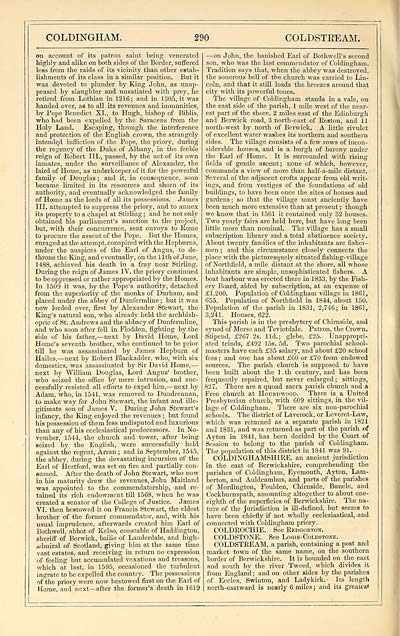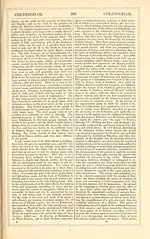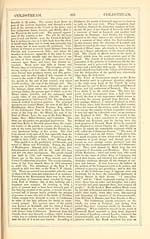Imperial gazeteer of Scotland, or, Dictionary of Scottish topography > Volume 1
(400) Page 290 - COL
Download files
Complete book:
Individual page:
Thumbnail gallery: Grid view | List view

COLDINGHAM.
290
COLDSTREAM.
on account of its patron saint being venerated
highly and alike on both sides of the Border, suffered
less from the raids of its vicinity than other estab-
lishments of its class in a similar position. But it
was devoted to plunder by King John, as unap-
peased by slaughter and unsatiated with prey, he
retired from Lothian in 1216; and in 1305, it was
handed over, as to all its revenues and immunities,
by Pope Benedict XI., to Hugh, bishop of Biblis,
who had been expelled by the Saracens from the
Holy Land. Escaping, through the interference
and protection of the English crown, the strangely
intended infliction of the Pope, the priory, during
the regency of the Duke of Albany, in the feeble
reign of Robert III., passed, by the act of its own
inmates, under the surveillance of Alexander, the
laird of Home, as underkeeper of it for the powerful
family of Douglas ; and it, in consequence, soon
became limited in its resources and shorn of its
authority, and eventually acknowledged the family
of Home as the lords of all its possessions. James
III. attempted to suppress the priory, and to annex
its property to a chapel at Stirling ; and he not only
obtained his parliament's sanction to the project,
but, with their concurrence, sent envoys to Borne
to procure the assent of the Pope. But the Homes,
enraged at the attempt, conspired with the Hepburns,
under the auspices of the Earl of Angus, to de-
throne the King, and eventually, on the 11th of June,
1488, achieved his death in a fray near Stirling.
During the reign of James IV. the priory continued
to he oppressed or rather appropriated by the Homes.
In 1509 it was, by the Pope's authority, detached
from the superiority of the monks of Durham, and
placed under the abbey of Dunfermline ; but it was
now lorded over, first by Alexander Stewart, the
King's natural son, who already held the archbish-
opric of St. Andrews and the abbacy of Dunfermline,
and who soon after fell in Flodden, fighting by the
side of his father, — next by David Home, Lord
Home's seventh brother, who continued to be prior
till he was assassinated by James Hepburn of
Hailes, — next by Bobert Blackadder, who, with six
domestics, was assassinated by Sir David Home, —
next by William Douglas, Lord Angus' brother,
who seized the office by mere intrusion, and suc-
cessfully resisted all efforts to expel him, — next by
Adam, who, in 1541, was removed to Dundrennan,
to make way for John Stewart, the infant and ille-
gitimate son of James V. During John Stewart's
infancy, the King enjoyed the revenues ; but found
his possession of them less undisputed and luxurious
than any of his ecclesiastical predecessors. In No-
vember, 1544, the church and tower, after being
seized by the English, were successfully held
against the regent, Arran ; and in September, 1545,
the abbey, during the devastating incursion of the
Earl of Hertford, was set on fire and partially con-
sumed. After the death of John Stewart, who now
in his maturity drew the revenues, John Maitland
was appointed to the commendatorship, and re-
tained its rich endowment till 1568, when he was
created a senator of the College of Justice. James
VI. then bestowed it on Francis Stewart, the eldest
brother of the former commendator, and, with his
usual imprudence, afterwards created him Earl of
Bothwell, abbot of Kelso, constable of Haddington,
sheriff of Berwick, bailie of Lauderdale, and high-
admiral of Scotland, giving him at the same time
vast estates, and receiving in return no expression
of feeling but accumulated vexations and treasons,
which at last, in 1595, occasioned the turbulent
ingrate to be expelled the country. The possessions
of the priory were now bestowed first on the Earl of
Home, and next— after the former's death in 1619
— on John, the banished Earl of Bothwell's second
son, who was the last commendator of Coldingham.
Tradition says that, when the abbey was destroyed,
the sonorous bell of the church was carried to Lin-
coln, and that it still loads the breezes around that
city with its powerful tones.
The village of Coldingham stands in a vale, on
the east side of the parish, 1 mile west of the near-
est part of the shore, 2 miles east of the Edinburgh
and Berwick road, 3 north-east of Boston, and 11
north-west by north of Berwick. A little rivulet
of excellent water washes its northern and southern
sides. The village consists of a few rows of incon-
siderable houses, and is a burgh of barony under
the Earl of Home. It is surrounded with rising
fields of gentle ascent; none of which, however,
commands a view of more than half-a-mile distant.
Several of the adjacent crofts appear from old writ-
ings, and from vestiges of the foundations of old
buildings, to have been once the sites of houses and
gardens; so that the village must anciently have
been much more extensive than at present ; though
we know that in 1561 it contained only 32 houses.
Two yearly fairs are held here, but have long been
little more than nominal. The village has a small
subscription library and a total abstinence society.
About twenty families of the inhabitants are fisher-
men ; and this circumstance closely connects the
place with the picturesquely situated fishing- village
of Northfield, a mile distant at the shore, all whose
inhabitants are simple, unsophisticated fishers. A
boat harbour was erected there in 1833, by the Fish-
ery Board, aided by subscription, at an expense of
£1,200. Population of Coldingham village in 1861,
655. Population of Northfield in 1844, about 150.
Population of the parish in 1831, 2,746; in 1861,
3,241. Houses, 622.
This parish is in the presbytery of Chimside, and
synod of Merse and Teviotdale. Patron, the Crown.
Stipend, £267 2s. lid.; glebe, £25. Unappropri-
ated teinds, £492 15s. 5d. Two parochial school-
masters have each £35 salary, and about £20 school
fees ; and one has about £60 or £70 from endowed
sources. The parish church is supposed to have
been built about the 1 - th century, and has been
frequently repaired, but never enlarged; sittings,
827. There are a quoad sacra parish church and a
Free church at Houndwood. There is a United
Presbyterian church, with 609 sittings, in the vil-
lage of Coldingham. There are six non-parochial
schools. The district of Laverock, or Leveret-Law,
which was returned as a separate parish in 1821
and 1831, and was returned as part of the parish of
Ayton in 1841, has been decided by the Court of
Session to belong to the parish of Coldingham.
The population of this district in 1841 was 91.
COLDINGHAMSHIRE, an ancient jurisdiction
in the east of Berwickshire, comprehending the
parishes of Coldingham, Eyemouth, Ayton, Lam-
berton, and Auldcambus, and parts of the parishes
of Mordington, Foulden, Chimside, Buncle, and
Cockbumspath, amounting altogether to about one-
eighth of the superficies of Berwickshire. The na-
ture of the jurisdiction is ill-defined, but seems to
have been chiefly if not wholly ecclesiastical, and
connected with Coldingham priory..
COLDKOCHIE. See Redgorton.
COLDSTONE. See Loqie- Coldstone.
COLDSTEEAM, a parish, containing a post and
market town of the same name, on the southern
border of Berwickshire. It is bounded on the east
and south by the river Tweed, which divides it
from England ; and on other sides by the parishes
of Eccles, Swinton, and Ladykirk.- Its length
north-eastward is nearly 6 miles ; and its greatcs'
290
COLDSTREAM.
on account of its patron saint being venerated
highly and alike on both sides of the Border, suffered
less from the raids of its vicinity than other estab-
lishments of its class in a similar position. But it
was devoted to plunder by King John, as unap-
peased by slaughter and unsatiated with prey, he
retired from Lothian in 1216; and in 1305, it was
handed over, as to all its revenues and immunities,
by Pope Benedict XI., to Hugh, bishop of Biblis,
who had been expelled by the Saracens from the
Holy Land. Escaping, through the interference
and protection of the English crown, the strangely
intended infliction of the Pope, the priory, during
the regency of the Duke of Albany, in the feeble
reign of Robert III., passed, by the act of its own
inmates, under the surveillance of Alexander, the
laird of Home, as underkeeper of it for the powerful
family of Douglas ; and it, in consequence, soon
became limited in its resources and shorn of its
authority, and eventually acknowledged the family
of Home as the lords of all its possessions. James
III. attempted to suppress the priory, and to annex
its property to a chapel at Stirling ; and he not only
obtained his parliament's sanction to the project,
but, with their concurrence, sent envoys to Borne
to procure the assent of the Pope. But the Homes,
enraged at the attempt, conspired with the Hepburns,
under the auspices of the Earl of Angus, to de-
throne the King, and eventually, on the 11th of June,
1488, achieved his death in a fray near Stirling.
During the reign of James IV. the priory continued
to he oppressed or rather appropriated by the Homes.
In 1509 it was, by the Pope's authority, detached
from the superiority of the monks of Durham, and
placed under the abbey of Dunfermline ; but it was
now lorded over, first by Alexander Stewart, the
King's natural son, who already held the archbish-
opric of St. Andrews and the abbacy of Dunfermline,
and who soon after fell in Flodden, fighting by the
side of his father, — next by David Home, Lord
Home's seventh brother, who continued to be prior
till he was assassinated by James Hepburn of
Hailes, — next by Bobert Blackadder, who, with six
domestics, was assassinated by Sir David Home, —
next by William Douglas, Lord Angus' brother,
who seized the office by mere intrusion, and suc-
cessfully resisted all efforts to expel him, — next by
Adam, who, in 1541, was removed to Dundrennan,
to make way for John Stewart, the infant and ille-
gitimate son of James V. During John Stewart's
infancy, the King enjoyed the revenues ; but found
his possession of them less undisputed and luxurious
than any of his ecclesiastical predecessors. In No-
vember, 1544, the church and tower, after being
seized by the English, were successfully held
against the regent, Arran ; and in September, 1545,
the abbey, during the devastating incursion of the
Earl of Hertford, was set on fire and partially con-
sumed. After the death of John Stewart, who now
in his maturity drew the revenues, John Maitland
was appointed to the commendatorship, and re-
tained its rich endowment till 1568, when he was
created a senator of the College of Justice. James
VI. then bestowed it on Francis Stewart, the eldest
brother of the former commendator, and, with his
usual imprudence, afterwards created him Earl of
Bothwell, abbot of Kelso, constable of Haddington,
sheriff of Berwick, bailie of Lauderdale, and high-
admiral of Scotland, giving him at the same time
vast estates, and receiving in return no expression
of feeling but accumulated vexations and treasons,
which at last, in 1595, occasioned the turbulent
ingrate to be expelled the country. The possessions
of the priory were now bestowed first on the Earl of
Home, and next— after the former's death in 1619
— on John, the banished Earl of Bothwell's second
son, who was the last commendator of Coldingham.
Tradition says that, when the abbey was destroyed,
the sonorous bell of the church was carried to Lin-
coln, and that it still loads the breezes around that
city with its powerful tones.
The village of Coldingham stands in a vale, on
the east side of the parish, 1 mile west of the near-
est part of the shore, 2 miles east of the Edinburgh
and Berwick road, 3 north-east of Boston, and 11
north-west by north of Berwick. A little rivulet
of excellent water washes its northern and southern
sides. The village consists of a few rows of incon-
siderable houses, and is a burgh of barony under
the Earl of Home. It is surrounded with rising
fields of gentle ascent; none of which, however,
commands a view of more than half-a-mile distant.
Several of the adjacent crofts appear from old writ-
ings, and from vestiges of the foundations of old
buildings, to have been once the sites of houses and
gardens; so that the village must anciently have
been much more extensive than at present ; though
we know that in 1561 it contained only 32 houses.
Two yearly fairs are held here, but have long been
little more than nominal. The village has a small
subscription library and a total abstinence society.
About twenty families of the inhabitants are fisher-
men ; and this circumstance closely connects the
place with the picturesquely situated fishing- village
of Northfield, a mile distant at the shore, all whose
inhabitants are simple, unsophisticated fishers. A
boat harbour was erected there in 1833, by the Fish-
ery Board, aided by subscription, at an expense of
£1,200. Population of Coldingham village in 1861,
655. Population of Northfield in 1844, about 150.
Population of the parish in 1831, 2,746; in 1861,
3,241. Houses, 622.
This parish is in the presbytery of Chimside, and
synod of Merse and Teviotdale. Patron, the Crown.
Stipend, £267 2s. lid.; glebe, £25. Unappropri-
ated teinds, £492 15s. 5d. Two parochial school-
masters have each £35 salary, and about £20 school
fees ; and one has about £60 or £70 from endowed
sources. The parish church is supposed to have
been built about the 1 - th century, and has been
frequently repaired, but never enlarged; sittings,
827. There are a quoad sacra parish church and a
Free church at Houndwood. There is a United
Presbyterian church, with 609 sittings, in the vil-
lage of Coldingham. There are six non-parochial
schools. The district of Laverock, or Leveret-Law,
which was returned as a separate parish in 1821
and 1831, and was returned as part of the parish of
Ayton in 1841, has been decided by the Court of
Session to belong to the parish of Coldingham.
The population of this district in 1841 was 91.
COLDINGHAMSHIRE, an ancient jurisdiction
in the east of Berwickshire, comprehending the
parishes of Coldingham, Eyemouth, Ayton, Lam-
berton, and Auldcambus, and parts of the parishes
of Mordington, Foulden, Chimside, Buncle, and
Cockbumspath, amounting altogether to about one-
eighth of the superficies of Berwickshire. The na-
ture of the jurisdiction is ill-defined, but seems to
have been chiefly if not wholly ecclesiastical, and
connected with Coldingham priory..
COLDKOCHIE. See Redgorton.
COLDSTONE. See Loqie- Coldstone.
COLDSTEEAM, a parish, containing a post and
market town of the same name, on the southern
border of Berwickshire. It is bounded on the east
and south by the river Tweed, which divides it
from England ; and on other sides by the parishes
of Eccles, Swinton, and Ladykirk.- Its length
north-eastward is nearly 6 miles ; and its greatcs'
Set display mode to: Large image | Transcription
Images and transcriptions on this page, including medium image downloads, may be used under the Creative Commons Attribution 4.0 International Licence unless otherwise stated. ![]()
| Gazetteers of Scotland, 1803-1901 > Imperial gazeteer of Scotland, or, Dictionary of Scottish topography > Volume 1 > (400) Page 290 - COL |
|---|
| Permanent URL | https://digital.nls.uk/97463930 |
|---|
| Description | Volume I: Aan-Gordon. |
|---|---|
| Attribution and copyright: |
|

